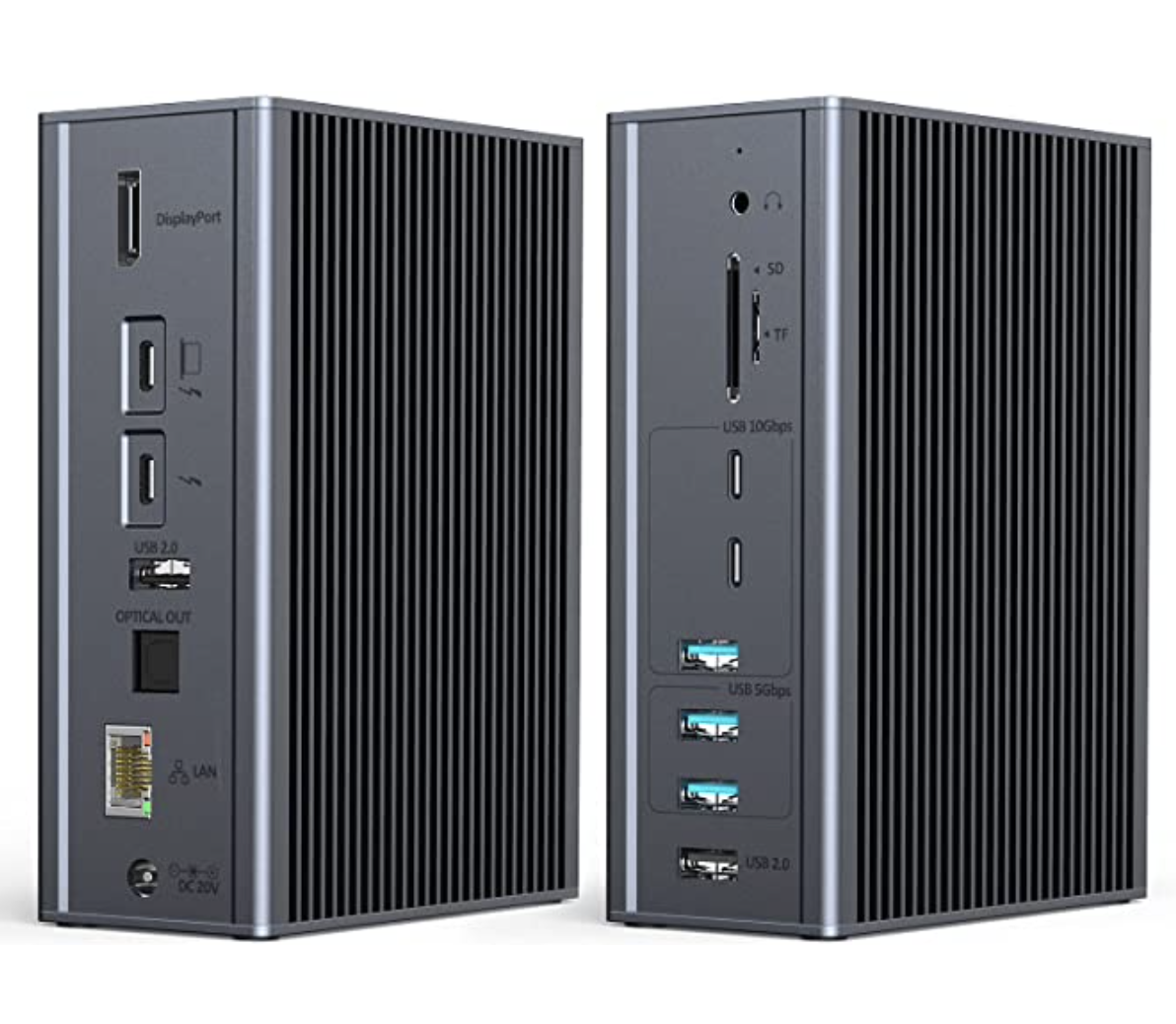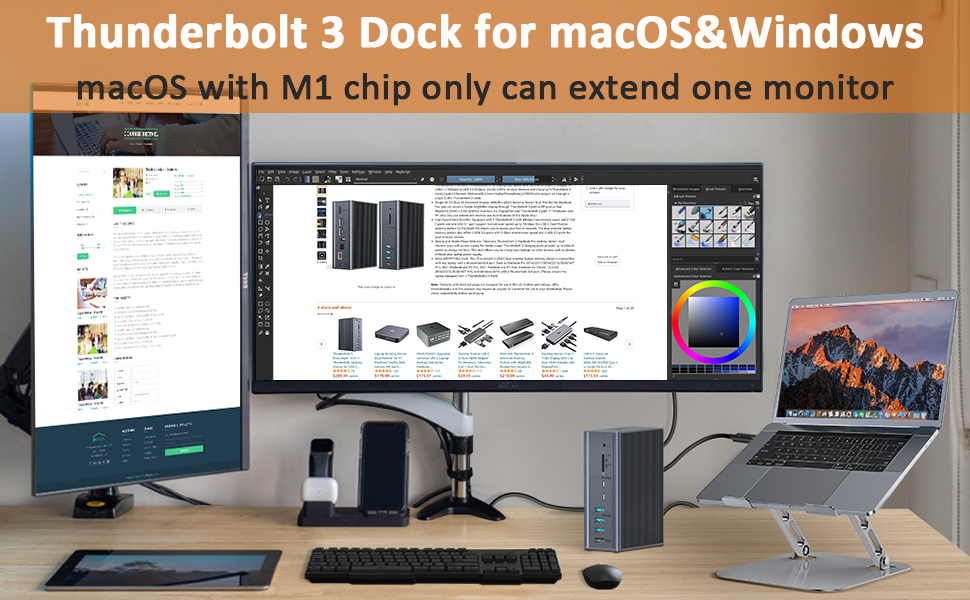
## My requirements:
As the proud owner of a new 14” MacBook Pro M1 Max, I wanted to use the computer as both a desktop (in a clamshell mode) as well as a conventional laptop. Given the number of existing peripheral devices that I had connected to my previous desktop, a 2017 iMac, I wanted to simplify the connections for ease of setup and tear down. A docking station seemed ideal.
Given that the MacBook Pro has three Thunderbolt 4 USB-C ports I was looking for a docking station that minimized the required number of dongles and adapters. The devices that were currently connected included:
- USB-A: Three external hard drives
- RJ-45: Ethernet connection for Internet access
- USB-A: High-speed scanner
- HDMI: 32” Samsung external monitor
- DC power to supply the MacBook during extended use
- USB-A: Stream Deck input device
- USB-A: External 1080p webcam
- Other USB-A devices used occasionally (e.g., flash drives)
I already used a USB-A hub with the iMac and decided to continue to use it if it was compatible with the new docking station. In addition, I wanted at least one Thunderbolt 3 or 4 connector to extend the MacBook’s Thunderbolt port. And while some of the ports could be at the rear of the docking station, I wanted at least one USB-C and USB-A port on the front in case I needed to access them easily. Other non-critical features would include a standard 3.5 mm audio jack and an SD Card reader.
My goal was to keep the price to around $200 based upon the offerings that I found online. But for that price I wanted something that was durable, too.
Enter the Tobenone
I quickly discovered a wide range of docking stations available from multiple retailers over a wide range of prices. Each had its own combination of features, making it a long process of winnowing down to the ones that most fit my needs. Traditional leading manufacturers include Belkin, Plugable, Dell, Kensington, and others.
Some of these are designed to physically support a laptop, while others simply have Thunderbolt and DC power connections. There tend to be two major classes: smaller, somewhat less capable docks, and larger docks with more features.
My research led me to the Tobenone Thunderbolt 3 docking station, available via Amazon for about $220. This is a “16-in-1” docking station that met most of my needs. Built solidly in a black/gray metal enclosure, this relatively compact device provides a wealth of connectivity. These features include:
- Connects directly to the computer’s Thunderbolt port using USB-C
- Provides 65-W charging for the MacBook
- Single Thunderbolt 3 port to extend the MacBook’s Thunderbolt port (40 Gbps)
- Two 10-Gbps USB-C ports
- One 10-Gbps USB 3.1 port
- Two 5-Gbps USB 3.0 ports
- Two USB 2.0 ports
- Gigabit Ethernet (RJ-45) port
- SD/MicroSD port
- One TF port
- One DisplayPort for external monitor
- One 3.5-mm audio/microphone port
- S/PDIF (audio output) port
Once unboxed the setup was quick and easy, with no hiccups. I added connections one at a time to verify them incrementally as a went along. The computer is connected via a USB-C port in the back of the docking station.

My Samsung monitor has an HDMI connector, but the Tobenone included several adapters, including an HDMI-to-DisplayPort, so no issue there. I plugged my standard USB-A (USB 3.0) hub into the dock and all of the devices connected to it were immediately available, including the webcam.
I also connected the hard drives directly into the docking station and they immediately mounted. Likewise, all of my other peripherals worked without incident. I also saw no degradation to my Internet connection due to the docking station.
Eventually, I was able to check out the audio (3.5-mm) and SD card connections which also performed perfectly. The docking station keeps my MacBook Pro charged and there have been no power-related glitches that I’ve seen so far.
The docking station is capable of driving two 4K (@60 Hz) monitors from a single Thunderbolt port on the MacBook, but only for Intel-based (non-M1) machines. That was one feature that I was not able to verify, although I’m inclined to take it on faith given everything else seems to work as advertised. The two other ports that I’m not using (and did not verify) are the TF card reader on the front and the optical output on the rear of the dock.
Tobenone claims that this docking station is compatible with a wide range of Windows and Mac computers, including MacBook Pros going back to 2016 and Windows PCs running Windows 8 or 10.
I give this product high marks for ease of use. It was really nice to set it up without having to download drivers or install unique software to initialize the hardware. The company seems to have engineers who have actually read and understood the many interface standards and as a result, have designed a very robust docking station that does what it’s supposed to do.
I will add that the docking station is pretty low-profile and unobtrusive. It is very quiet. It has one single small LED indicator on the front to let you know that it’s powered on but otherwise doesn’t have any visual clutter than might get in the way of use. It is the rare product that really has no significant deficiencies.


Will it support the clamshell mode for the MacBook Air M1?
Асфальтирование – это многоэтапный процесс, требующий соблюдения технологических норм и использования специализированной техники. Качественно уложенный асфальт – это залог долговечности дорожного покрытия, его устойчивости к нагрузкам и неблагоприятным погодным условиям.
Подготовка основания: Этот этап – фундамент будущего покрытия. Сначала производится очистка территории от мусора, растительности и старого покрытия. Затем выполняется выравнивание основания с использованием геодезических инструментов. При необходимости, проводится укрепление грунта, например, с помощью геосетки. Важно обеспечить хороший дренаж, чтобы избежать скопления воды под асфальтом.
Укладка щебёночного основания: Щебень служит дренажным слоем и распределяет нагрузку от транспорта. Сначала укладывается крупная фракция, затем более мелкая. Каждый слой тщательно утрамбовывается катком. Толщина щебёночного основания зависит от предполагаемой нагрузки на дорогу.
Укладка асфальтобетонной смеси: Асфальтобетонная смесь доставляется на место укладки в специальных термоизолированных машинах. Смесь равномерно распределяется по основанию с помощью асфальтоукладчика. Важно соблюдать температурный режим укладки, чтобы обеспечить оптимальную плотность и прочность покрытия.
Уплотнение асфальта: Уплотнение асфальта производится с помощью катков различных типов. Сначала используются лёгкие катки для предварительного уплотнения, затем более тяжёлые – для окончательного. Уплотнение необходимо проводить до полного остывания смеси.
Контроль качества: На каждом этапе укладки асфальта необходимо проводить контроль качества. Проверяется ровность основания, толщина слоёв, температура смеси и степень уплотнения. Делитесь своим опытом и подрядчиками на укладка асфальта санкт петербург